University Assignment: Legal Aspects of Business, Equality Act 2010
VerifiedAdded on 2023/01/19
|9
|4057
|82
Report
AI Summary
This report analyzes the Equality Act 2010, focusing on disability discrimination in the workplace, particularly concerning employees with health conditions like cancer. It begins with an overview of the Act's background, including the context of the Stephen Lawrence murder and the subsequent need for legislative changes to combat discrimination. The report then delves into the Act's provisions regarding disability discrimination, defining disability and outlining the protections afforded to disabled individuals. It uses the case of James, an employee with a pre-cancerous condition, to illustrate how the Act applies and explores the rights and obligations of both the employee and the employer, Alex. The report covers topics like reasonable adjustments, protection from direct and indirect discrimination, and harassment. It also highlights Alex's obligations regarding employee privacy, medical information, and leave and sick pay, providing a comprehensive understanding of the Act's implications in a real-world scenario. The report emphasizes the importance of creating a supportive and non-discriminatory workplace environment, in line with the Equality Act 2010.
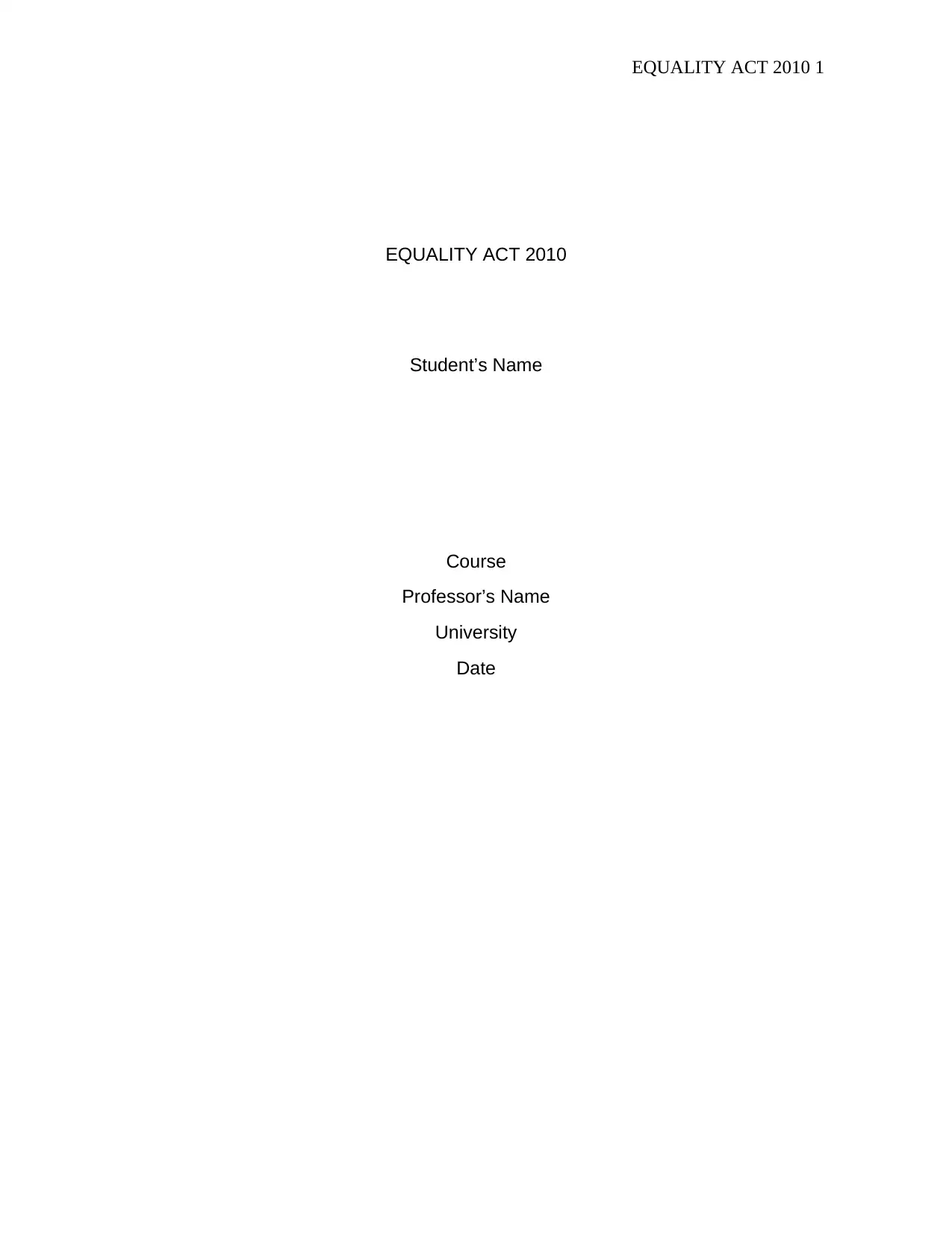
EQUALITY ACT 2010 1
EQUALITY ACT 2010
Student’s Name
Course
Professor’s Name
University
Date
EQUALITY ACT 2010
Student’s Name
Course
Professor’s Name
University
Date
Paraphrase This Document
Need a fresh take? Get an instant paraphrase of this document with our AI Paraphraser
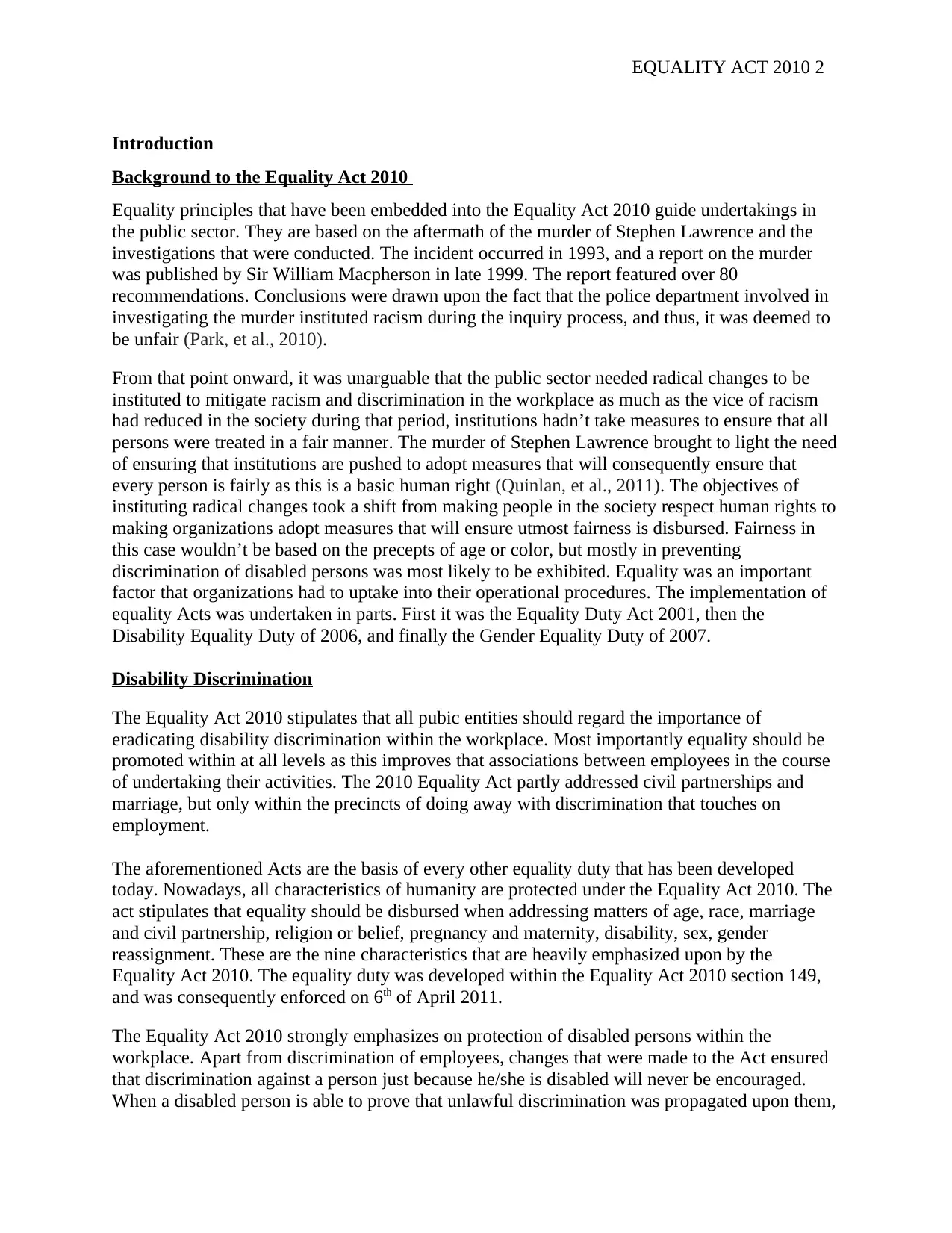
EQUALITY ACT 2010 2
Introduction
Background to the Equality Act 2010
Equality principles that have been embedded into the Equality Act 2010 guide undertakings in
the public sector. They are based on the aftermath of the murder of Stephen Lawrence and the
investigations that were conducted. The incident occurred in 1993, and a report on the murder
was published by Sir William Macpherson in late 1999. The report featured over 80
recommendations. Conclusions were drawn upon the fact that the police department involved in
investigating the murder instituted racism during the inquiry process, and thus, it was deemed to
be unfair (Park, et al., 2010).
From that point onward, it was unarguable that the public sector needed radical changes to be
instituted to mitigate racism and discrimination in the workplace as much as the vice of racism
had reduced in the society during that period, institutions hadn’t take measures to ensure that all
persons were treated in a fair manner. The murder of Stephen Lawrence brought to light the need
of ensuring that institutions are pushed to adopt measures that will consequently ensure that
every person is fairly as this is a basic human right (Quinlan, et al., 2011). The objectives of
instituting radical changes took a shift from making people in the society respect human rights to
making organizations adopt measures that will ensure utmost fairness is disbursed. Fairness in
this case wouldn’t be based on the precepts of age or color, but mostly in preventing
discrimination of disabled persons was most likely to be exhibited. Equality was an important
factor that organizations had to uptake into their operational procedures. The implementation of
equality Acts was undertaken in parts. First it was the Equality Duty Act 2001, then the
Disability Equality Duty of 2006, and finally the Gender Equality Duty of 2007.
Disability Discrimination
The Equality Act 2010 stipulates that all pubic entities should regard the importance of
eradicating disability discrimination within the workplace. Most importantly equality should be
promoted within at all levels as this improves that associations between employees in the course
of undertaking their activities. The 2010 Equality Act partly addressed civil partnerships and
marriage, but only within the precincts of doing away with discrimination that touches on
employment.
The aforementioned Acts are the basis of every other equality duty that has been developed
today. Nowadays, all characteristics of humanity are protected under the Equality Act 2010. The
act stipulates that equality should be disbursed when addressing matters of age, race, marriage
and civil partnership, religion or belief, pregnancy and maternity, disability, sex, gender
reassignment. These are the nine characteristics that are heavily emphasized upon by the
Equality Act 2010. The equality duty was developed within the Equality Act 2010 section 149,
and was consequently enforced on 6th of April 2011.
The Equality Act 2010 strongly emphasizes on protection of disabled persons within the
workplace. Apart from discrimination of employees, changes that were made to the Act ensured
that discrimination against a person just because he/she is disabled will never be encouraged.
When a disabled person is able to prove that unlawful discrimination was propagated upon them,
Introduction
Background to the Equality Act 2010
Equality principles that have been embedded into the Equality Act 2010 guide undertakings in
the public sector. They are based on the aftermath of the murder of Stephen Lawrence and the
investigations that were conducted. The incident occurred in 1993, and a report on the murder
was published by Sir William Macpherson in late 1999. The report featured over 80
recommendations. Conclusions were drawn upon the fact that the police department involved in
investigating the murder instituted racism during the inquiry process, and thus, it was deemed to
be unfair (Park, et al., 2010).
From that point onward, it was unarguable that the public sector needed radical changes to be
instituted to mitigate racism and discrimination in the workplace as much as the vice of racism
had reduced in the society during that period, institutions hadn’t take measures to ensure that all
persons were treated in a fair manner. The murder of Stephen Lawrence brought to light the need
of ensuring that institutions are pushed to adopt measures that will consequently ensure that
every person is fairly as this is a basic human right (Quinlan, et al., 2011). The objectives of
instituting radical changes took a shift from making people in the society respect human rights to
making organizations adopt measures that will ensure utmost fairness is disbursed. Fairness in
this case wouldn’t be based on the precepts of age or color, but mostly in preventing
discrimination of disabled persons was most likely to be exhibited. Equality was an important
factor that organizations had to uptake into their operational procedures. The implementation of
equality Acts was undertaken in parts. First it was the Equality Duty Act 2001, then the
Disability Equality Duty of 2006, and finally the Gender Equality Duty of 2007.
Disability Discrimination
The Equality Act 2010 stipulates that all pubic entities should regard the importance of
eradicating disability discrimination within the workplace. Most importantly equality should be
promoted within at all levels as this improves that associations between employees in the course
of undertaking their activities. The 2010 Equality Act partly addressed civil partnerships and
marriage, but only within the precincts of doing away with discrimination that touches on
employment.
The aforementioned Acts are the basis of every other equality duty that has been developed
today. Nowadays, all characteristics of humanity are protected under the Equality Act 2010. The
act stipulates that equality should be disbursed when addressing matters of age, race, marriage
and civil partnership, religion or belief, pregnancy and maternity, disability, sex, gender
reassignment. These are the nine characteristics that are heavily emphasized upon by the
Equality Act 2010. The equality duty was developed within the Equality Act 2010 section 149,
and was consequently enforced on 6th of April 2011.
The Equality Act 2010 strongly emphasizes on protection of disabled persons within the
workplace. Apart from discrimination of employees, changes that were made to the Act ensured
that discrimination against a person just because he/she is disabled will never be encouraged.
When a disabled person is able to prove that unlawful discrimination was propagated upon them,
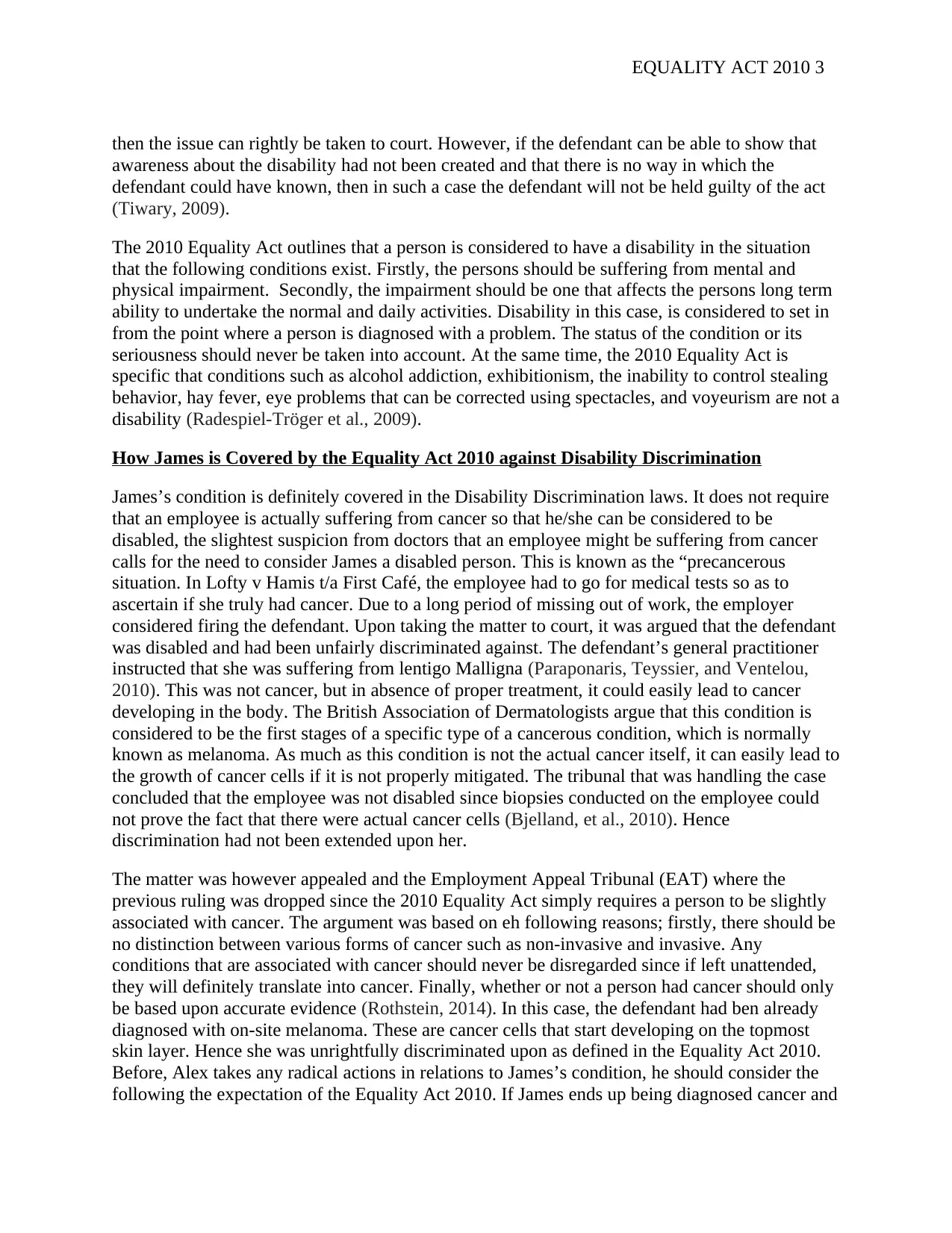
EQUALITY ACT 2010 3
then the issue can rightly be taken to court. However, if the defendant can be able to show that
awareness about the disability had not been created and that there is no way in which the
defendant could have known, then in such a case the defendant will not be held guilty of the act
(Tiwary, 2009).
The 2010 Equality Act outlines that a person is considered to have a disability in the situation
that the following conditions exist. Firstly, the persons should be suffering from mental and
physical impairment. Secondly, the impairment should be one that affects the persons long term
ability to undertake the normal and daily activities. Disability in this case, is considered to set in
from the point where a person is diagnosed with a problem. The status of the condition or its
seriousness should never be taken into account. At the same time, the 2010 Equality Act is
specific that conditions such as alcohol addiction, exhibitionism, the inability to control stealing
behavior, hay fever, eye problems that can be corrected using spectacles, and voyeurism are not a
disability (Radespiel-Tröger et al., 2009).
How James is Covered by the Equality Act 2010 against Disability Discrimination
James’s condition is definitely covered in the Disability Discrimination laws. It does not require
that an employee is actually suffering from cancer so that he/she can be considered to be
disabled, the slightest suspicion from doctors that an employee might be suffering from cancer
calls for the need to consider James a disabled person. This is known as the “precancerous
situation. In Lofty v Hamis t/a First Café, the employee had to go for medical tests so as to
ascertain if she truly had cancer. Due to a long period of missing out of work, the employer
considered firing the defendant. Upon taking the matter to court, it was argued that the defendant
was disabled and had been unfairly discriminated against. The defendant’s general practitioner
instructed that she was suffering from lentigo Malligna (Paraponaris, Teyssier, and Ventelou,
2010). This was not cancer, but in absence of proper treatment, it could easily lead to cancer
developing in the body. The British Association of Dermatologists argue that this condition is
considered to be the first stages of a specific type of a cancerous condition, which is normally
known as melanoma. As much as this condition is not the actual cancer itself, it can easily lead to
the growth of cancer cells if it is not properly mitigated. The tribunal that was handling the case
concluded that the employee was not disabled since biopsies conducted on the employee could
not prove the fact that there were actual cancer cells (Bjelland, et al., 2010). Hence
discrimination had not been extended upon her.
The matter was however appealed and the Employment Appeal Tribunal (EAT) where the
previous ruling was dropped since the 2010 Equality Act simply requires a person to be slightly
associated with cancer. The argument was based on eh following reasons; firstly, there should be
no distinction between various forms of cancer such as non-invasive and invasive. Any
conditions that are associated with cancer should never be disregarded since if left unattended,
they will definitely translate into cancer. Finally, whether or not a person had cancer should only
be based upon accurate evidence (Rothstein, 2014). In this case, the defendant had ben already
diagnosed with on-site melanoma. These are cancer cells that start developing on the topmost
skin layer. Hence she was unrightfully discriminated upon as defined in the Equality Act 2010.
Before, Alex takes any radical actions in relations to James’s condition, he should consider the
following the expectation of the Equality Act 2010. If James ends up being diagnosed cancer and
then the issue can rightly be taken to court. However, if the defendant can be able to show that
awareness about the disability had not been created and that there is no way in which the
defendant could have known, then in such a case the defendant will not be held guilty of the act
(Tiwary, 2009).
The 2010 Equality Act outlines that a person is considered to have a disability in the situation
that the following conditions exist. Firstly, the persons should be suffering from mental and
physical impairment. Secondly, the impairment should be one that affects the persons long term
ability to undertake the normal and daily activities. Disability in this case, is considered to set in
from the point where a person is diagnosed with a problem. The status of the condition or its
seriousness should never be taken into account. At the same time, the 2010 Equality Act is
specific that conditions such as alcohol addiction, exhibitionism, the inability to control stealing
behavior, hay fever, eye problems that can be corrected using spectacles, and voyeurism are not a
disability (Radespiel-Tröger et al., 2009).
How James is Covered by the Equality Act 2010 against Disability Discrimination
James’s condition is definitely covered in the Disability Discrimination laws. It does not require
that an employee is actually suffering from cancer so that he/she can be considered to be
disabled, the slightest suspicion from doctors that an employee might be suffering from cancer
calls for the need to consider James a disabled person. This is known as the “precancerous
situation. In Lofty v Hamis t/a First Café, the employee had to go for medical tests so as to
ascertain if she truly had cancer. Due to a long period of missing out of work, the employer
considered firing the defendant. Upon taking the matter to court, it was argued that the defendant
was disabled and had been unfairly discriminated against. The defendant’s general practitioner
instructed that she was suffering from lentigo Malligna (Paraponaris, Teyssier, and Ventelou,
2010). This was not cancer, but in absence of proper treatment, it could easily lead to cancer
developing in the body. The British Association of Dermatologists argue that this condition is
considered to be the first stages of a specific type of a cancerous condition, which is normally
known as melanoma. As much as this condition is not the actual cancer itself, it can easily lead to
the growth of cancer cells if it is not properly mitigated. The tribunal that was handling the case
concluded that the employee was not disabled since biopsies conducted on the employee could
not prove the fact that there were actual cancer cells (Bjelland, et al., 2010). Hence
discrimination had not been extended upon her.
The matter was however appealed and the Employment Appeal Tribunal (EAT) where the
previous ruling was dropped since the 2010 Equality Act simply requires a person to be slightly
associated with cancer. The argument was based on eh following reasons; firstly, there should be
no distinction between various forms of cancer such as non-invasive and invasive. Any
conditions that are associated with cancer should never be disregarded since if left unattended,
they will definitely translate into cancer. Finally, whether or not a person had cancer should only
be based upon accurate evidence (Rothstein, 2014). In this case, the defendant had ben already
diagnosed with on-site melanoma. These are cancer cells that start developing on the topmost
skin layer. Hence she was unrightfully discriminated upon as defined in the Equality Act 2010.
Before, Alex takes any radical actions in relations to James’s condition, he should consider the
following the expectation of the Equality Act 2010. If James ends up being diagnosed cancer and
⊘ This is a preview!⊘
Do you want full access?
Subscribe today to unlock all pages.

Trusted by 1+ million students worldwide
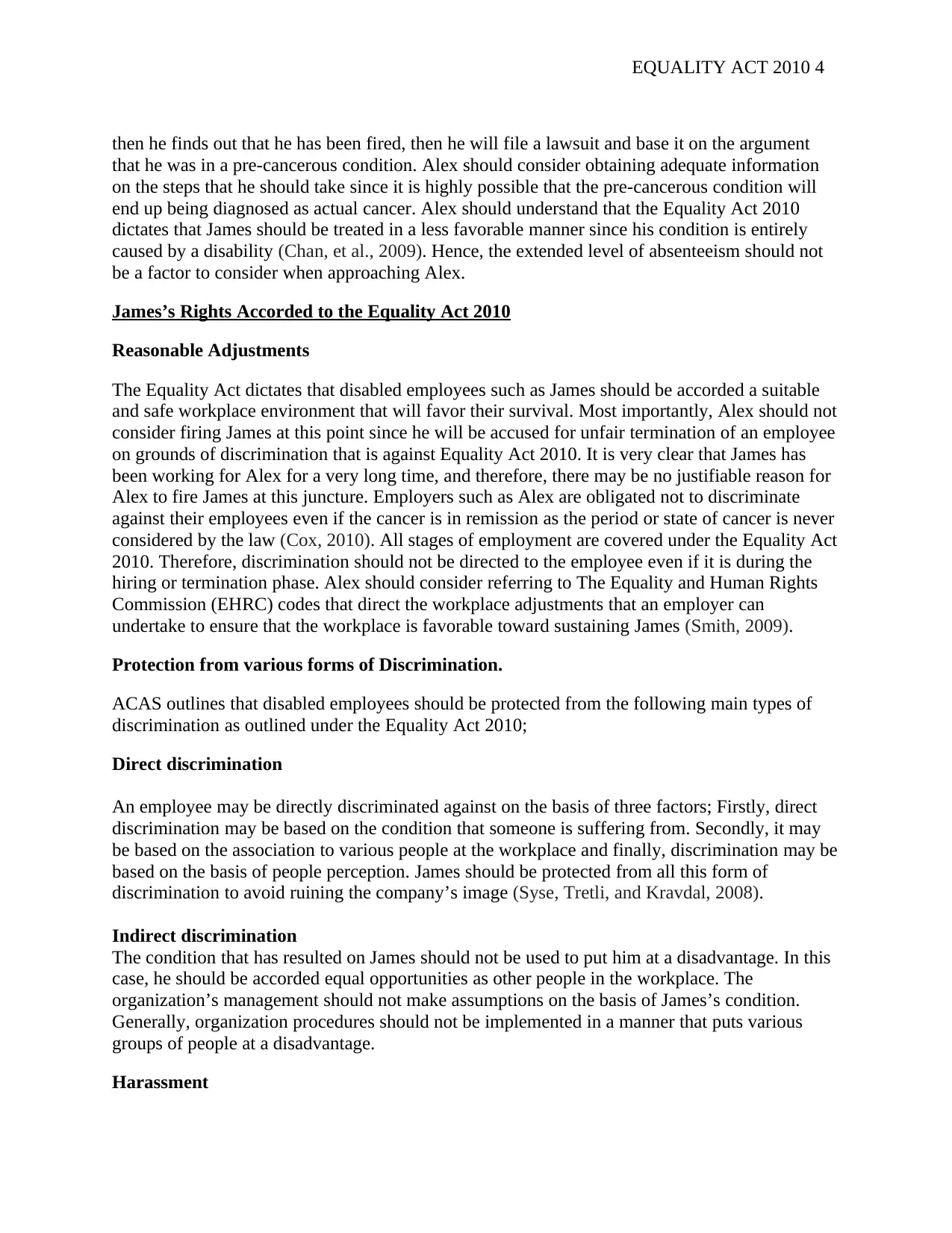
EQUALITY ACT 2010 4
then he finds out that he has been fired, then he will file a lawsuit and base it on the argument
that he was in a pre-cancerous condition. Alex should consider obtaining adequate information
on the steps that he should take since it is highly possible that the pre-cancerous condition will
end up being diagnosed as actual cancer. Alex should understand that the Equality Act 2010
dictates that James should be treated in a less favorable manner since his condition is entirely
caused by a disability (Chan, et al., 2009). Hence, the extended level of absenteeism should not
be a factor to consider when approaching Alex.
James’s Rights Accorded to the Equality Act 2010
Reasonable Adjustments
The Equality Act dictates that disabled employees such as James should be accorded a suitable
and safe workplace environment that will favor their survival. Most importantly, Alex should not
consider firing James at this point since he will be accused for unfair termination of an employee
on grounds of discrimination that is against Equality Act 2010. It is very clear that James has
been working for Alex for a very long time, and therefore, there may be no justifiable reason for
Alex to fire James at this juncture. Employers such as Alex are obligated not to discriminate
against their employees even if the cancer is in remission as the period or state of cancer is never
considered by the law (Cox, 2010). All stages of employment are covered under the Equality Act
2010. Therefore, discrimination should not be directed to the employee even if it is during the
hiring or termination phase. Alex should consider referring to The Equality and Human Rights
Commission (EHRC) codes that direct the workplace adjustments that an employer can
undertake to ensure that the workplace is favorable toward sustaining James (Smith, 2009).
Protection from various forms of Discrimination.
ACAS outlines that disabled employees should be protected from the following main types of
discrimination as outlined under the Equality Act 2010;
Direct discrimination
An employee may be directly discriminated against on the basis of three factors; Firstly, direct
discrimination may be based on the condition that someone is suffering from. Secondly, it may
be based on the association to various people at the workplace and finally, discrimination may be
based on the basis of people perception. James should be protected from all this form of
discrimination to avoid ruining the company’s image (Syse, Tretli, and Kravdal, 2008).
Indirect discrimination
The condition that has resulted on James should not be used to put him at a disadvantage. In this
case, he should be accorded equal opportunities as other people in the workplace. The
organization’s management should not make assumptions on the basis of James’s condition.
Generally, organization procedures should not be implemented in a manner that puts various
groups of people at a disadvantage.
Harassment
then he finds out that he has been fired, then he will file a lawsuit and base it on the argument
that he was in a pre-cancerous condition. Alex should consider obtaining adequate information
on the steps that he should take since it is highly possible that the pre-cancerous condition will
end up being diagnosed as actual cancer. Alex should understand that the Equality Act 2010
dictates that James should be treated in a less favorable manner since his condition is entirely
caused by a disability (Chan, et al., 2009). Hence, the extended level of absenteeism should not
be a factor to consider when approaching Alex.
James’s Rights Accorded to the Equality Act 2010
Reasonable Adjustments
The Equality Act dictates that disabled employees such as James should be accorded a suitable
and safe workplace environment that will favor their survival. Most importantly, Alex should not
consider firing James at this point since he will be accused for unfair termination of an employee
on grounds of discrimination that is against Equality Act 2010. It is very clear that James has
been working for Alex for a very long time, and therefore, there may be no justifiable reason for
Alex to fire James at this juncture. Employers such as Alex are obligated not to discriminate
against their employees even if the cancer is in remission as the period or state of cancer is never
considered by the law (Cox, 2010). All stages of employment are covered under the Equality Act
2010. Therefore, discrimination should not be directed to the employee even if it is during the
hiring or termination phase. Alex should consider referring to The Equality and Human Rights
Commission (EHRC) codes that direct the workplace adjustments that an employer can
undertake to ensure that the workplace is favorable toward sustaining James (Smith, 2009).
Protection from various forms of Discrimination.
ACAS outlines that disabled employees should be protected from the following main types of
discrimination as outlined under the Equality Act 2010;
Direct discrimination
An employee may be directly discriminated against on the basis of three factors; Firstly, direct
discrimination may be based on the condition that someone is suffering from. Secondly, it may
be based on the association to various people at the workplace and finally, discrimination may be
based on the basis of people perception. James should be protected from all this form of
discrimination to avoid ruining the company’s image (Syse, Tretli, and Kravdal, 2008).
Indirect discrimination
The condition that has resulted on James should not be used to put him at a disadvantage. In this
case, he should be accorded equal opportunities as other people in the workplace. The
organization’s management should not make assumptions on the basis of James’s condition.
Generally, organization procedures should not be implemented in a manner that puts various
groups of people at a disadvantage.
Harassment
Paraphrase This Document
Need a fresh take? Get an instant paraphrase of this document with our AI Paraphraser
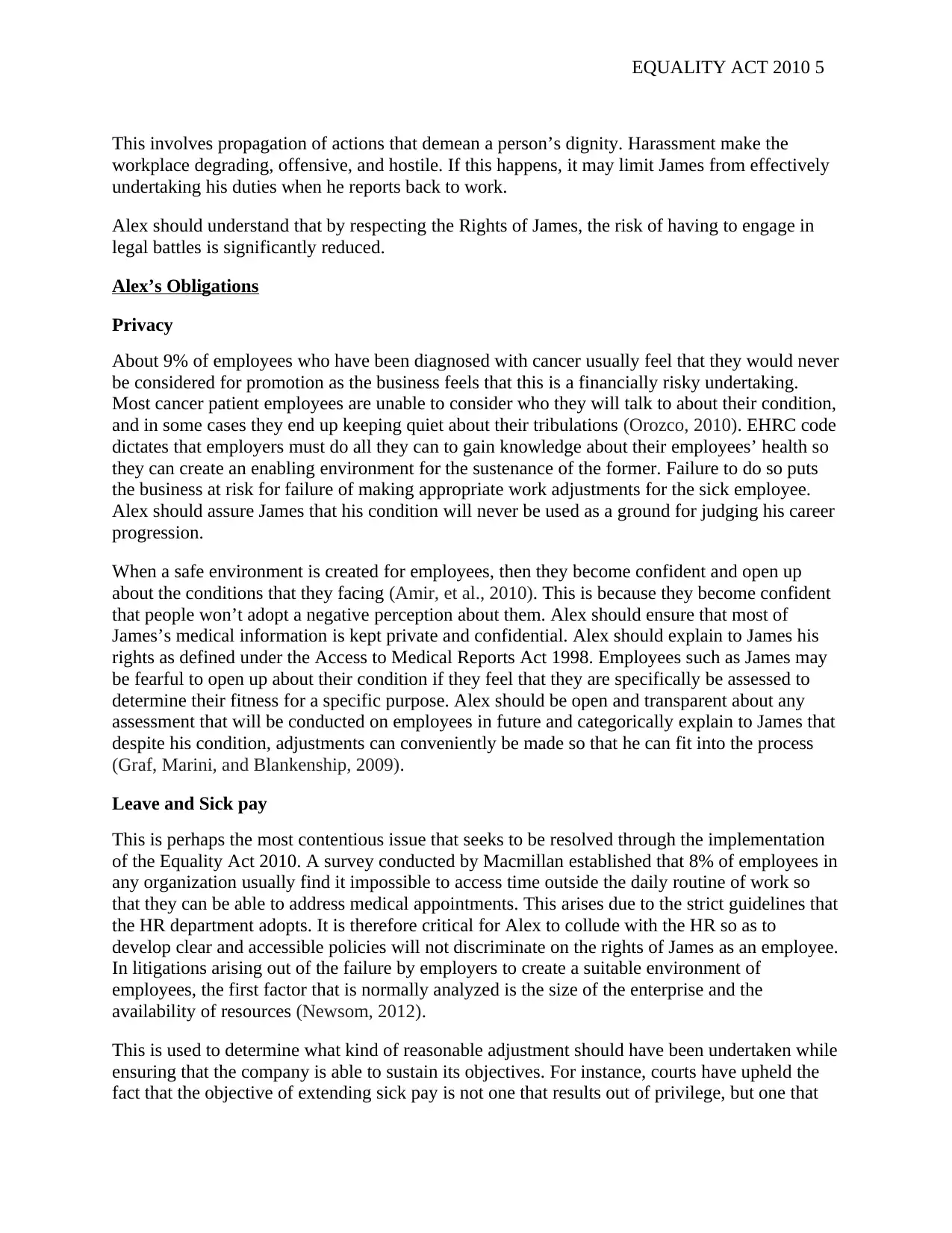
EQUALITY ACT 2010 5
This involves propagation of actions that demean a person’s dignity. Harassment make the
workplace degrading, offensive, and hostile. If this happens, it may limit James from effectively
undertaking his duties when he reports back to work.
Alex should understand that by respecting the Rights of James, the risk of having to engage in
legal battles is significantly reduced.
Alex’s Obligations
Privacy
About 9% of employees who have been diagnosed with cancer usually feel that they would never
be considered for promotion as the business feels that this is a financially risky undertaking.
Most cancer patient employees are unable to consider who they will talk to about their condition,
and in some cases they end up keeping quiet about their tribulations (Orozco, 2010). EHRC code
dictates that employers must do all they can to gain knowledge about their employees’ health so
they can create an enabling environment for the sustenance of the former. Failure to do so puts
the business at risk for failure of making appropriate work adjustments for the sick employee.
Alex should assure James that his condition will never be used as a ground for judging his career
progression.
When a safe environment is created for employees, then they become confident and open up
about the conditions that they facing (Amir, et al., 2010). This is because they become confident
that people won’t adopt a negative perception about them. Alex should ensure that most of
James’s medical information is kept private and confidential. Alex should explain to James his
rights as defined under the Access to Medical Reports Act 1998. Employees such as James may
be fearful to open up about their condition if they feel that they are specifically be assessed to
determine their fitness for a specific purpose. Alex should be open and transparent about any
assessment that will be conducted on employees in future and categorically explain to James that
despite his condition, adjustments can conveniently be made so that he can fit into the process
(Graf, Marini, and Blankenship, 2009).
Leave and Sick pay
This is perhaps the most contentious issue that seeks to be resolved through the implementation
of the Equality Act 2010. A survey conducted by Macmillan established that 8% of employees in
any organization usually find it impossible to access time outside the daily routine of work so
that they can be able to address medical appointments. This arises due to the strict guidelines that
the HR department adopts. It is therefore critical for Alex to collude with the HR so as to
develop clear and accessible policies will not discriminate on the rights of James as an employee.
In litigations arising out of the failure by employers to create a suitable environment of
employees, the first factor that is normally analyzed is the size of the enterprise and the
availability of resources (Newsom, 2012).
This is used to determine what kind of reasonable adjustment should have been undertaken while
ensuring that the company is able to sustain its objectives. For instance, courts have upheld the
fact that the objective of extending sick pay is not one that results out of privilege, but one that
This involves propagation of actions that demean a person’s dignity. Harassment make the
workplace degrading, offensive, and hostile. If this happens, it may limit James from effectively
undertaking his duties when he reports back to work.
Alex should understand that by respecting the Rights of James, the risk of having to engage in
legal battles is significantly reduced.
Alex’s Obligations
Privacy
About 9% of employees who have been diagnosed with cancer usually feel that they would never
be considered for promotion as the business feels that this is a financially risky undertaking.
Most cancer patient employees are unable to consider who they will talk to about their condition,
and in some cases they end up keeping quiet about their tribulations (Orozco, 2010). EHRC code
dictates that employers must do all they can to gain knowledge about their employees’ health so
they can create an enabling environment for the sustenance of the former. Failure to do so puts
the business at risk for failure of making appropriate work adjustments for the sick employee.
Alex should assure James that his condition will never be used as a ground for judging his career
progression.
When a safe environment is created for employees, then they become confident and open up
about the conditions that they facing (Amir, et al., 2010). This is because they become confident
that people won’t adopt a negative perception about them. Alex should ensure that most of
James’s medical information is kept private and confidential. Alex should explain to James his
rights as defined under the Access to Medical Reports Act 1998. Employees such as James may
be fearful to open up about their condition if they feel that they are specifically be assessed to
determine their fitness for a specific purpose. Alex should be open and transparent about any
assessment that will be conducted on employees in future and categorically explain to James that
despite his condition, adjustments can conveniently be made so that he can fit into the process
(Graf, Marini, and Blankenship, 2009).
Leave and Sick pay
This is perhaps the most contentious issue that seeks to be resolved through the implementation
of the Equality Act 2010. A survey conducted by Macmillan established that 8% of employees in
any organization usually find it impossible to access time outside the daily routine of work so
that they can be able to address medical appointments. This arises due to the strict guidelines that
the HR department adopts. It is therefore critical for Alex to collude with the HR so as to
develop clear and accessible policies will not discriminate on the rights of James as an employee.
In litigations arising out of the failure by employers to create a suitable environment of
employees, the first factor that is normally analyzed is the size of the enterprise and the
availability of resources (Newsom, 2012).
This is used to determine what kind of reasonable adjustment should have been undertaken while
ensuring that the company is able to sustain its objectives. For instance, courts have upheld the
fact that the objective of extending sick pay is not one that results out of privilege, but one that
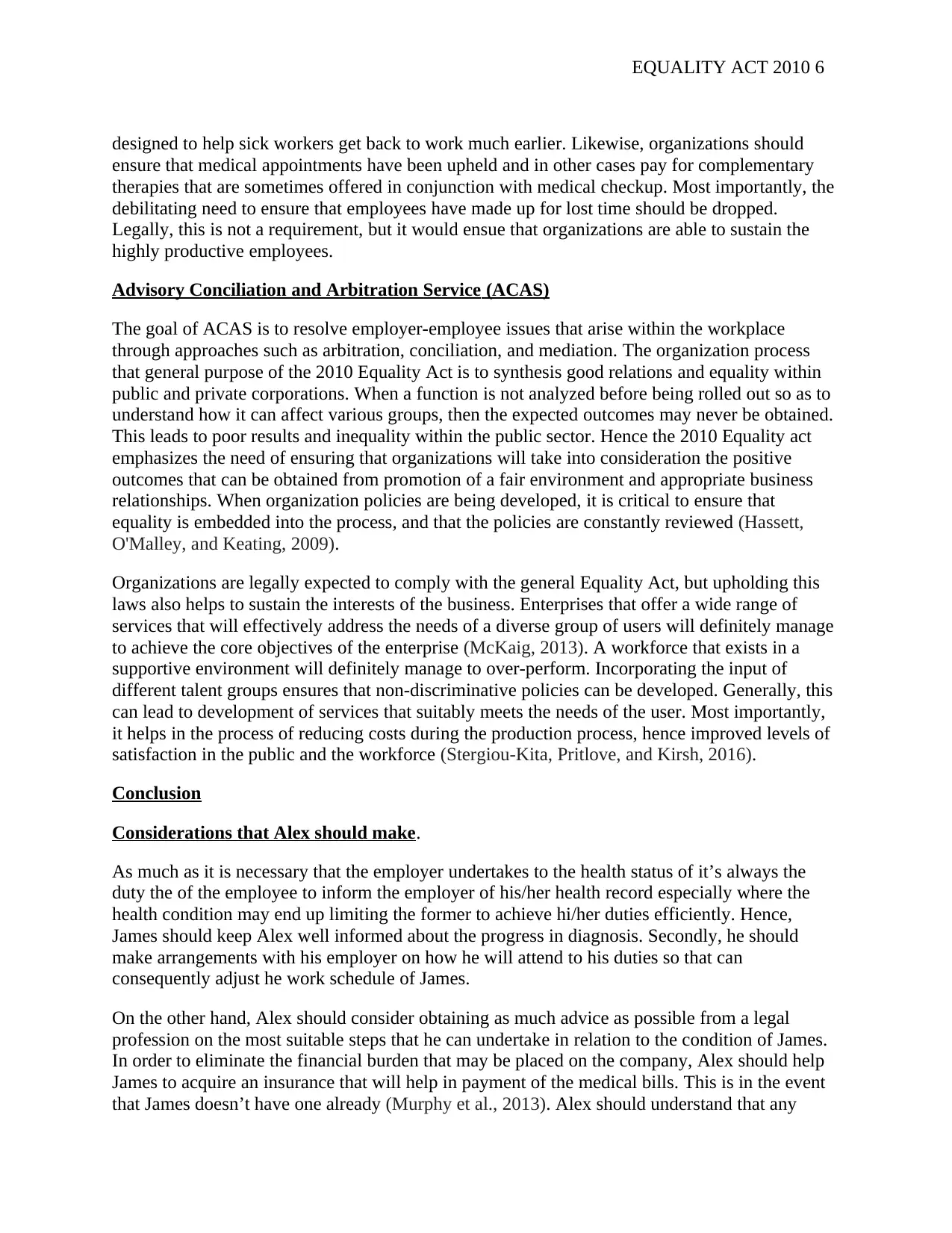
EQUALITY ACT 2010 6
designed to help sick workers get back to work much earlier. Likewise, organizations should
ensure that medical appointments have been upheld and in other cases pay for complementary
therapies that are sometimes offered in conjunction with medical checkup. Most importantly, the
debilitating need to ensure that employees have made up for lost time should be dropped.
Legally, this is not a requirement, but it would ensue that organizations are able to sustain the
highly productive employees.
Advisory Conciliation and Arbitration Service (ACAS)
The goal of ACAS is to resolve employer-employee issues that arise within the workplace
through approaches such as arbitration, conciliation, and mediation. The organization process
that general purpose of the 2010 Equality Act is to synthesis good relations and equality within
public and private corporations. When a function is not analyzed before being rolled out so as to
understand how it can affect various groups, then the expected outcomes may never be obtained.
This leads to poor results and inequality within the public sector. Hence the 2010 Equality act
emphasizes the need of ensuring that organizations will take into consideration the positive
outcomes that can be obtained from promotion of a fair environment and appropriate business
relationships. When organization policies are being developed, it is critical to ensure that
equality is embedded into the process, and that the policies are constantly reviewed (Hassett,
O'Malley, and Keating, 2009).
Organizations are legally expected to comply with the general Equality Act, but upholding this
laws also helps to sustain the interests of the business. Enterprises that offer a wide range of
services that will effectively address the needs of a diverse group of users will definitely manage
to achieve the core objectives of the enterprise (McKaig, 2013). A workforce that exists in a
supportive environment will definitely manage to over-perform. Incorporating the input of
different talent groups ensures that non-discriminative policies can be developed. Generally, this
can lead to development of services that suitably meets the needs of the user. Most importantly,
it helps in the process of reducing costs during the production process, hence improved levels of
satisfaction in the public and the workforce (Stergiou-Kita, Pritlove, and Kirsh, 2016).
Conclusion
Considerations that Alex should make.
As much as it is necessary that the employer undertakes to the health status of it’s always the
duty the of the employee to inform the employer of his/her health record especially where the
health condition may end up limiting the former to achieve hi/her duties efficiently. Hence,
James should keep Alex well informed about the progress in diagnosis. Secondly, he should
make arrangements with his employer on how he will attend to his duties so that can
consequently adjust he work schedule of James.
On the other hand, Alex should consider obtaining as much advice as possible from a legal
profession on the most suitable steps that he can undertake in relation to the condition of James.
In order to eliminate the financial burden that may be placed on the company, Alex should help
James to acquire an insurance that will help in payment of the medical bills. This is in the event
that James doesn’t have one already (Murphy et al., 2013). Alex should understand that any
designed to help sick workers get back to work much earlier. Likewise, organizations should
ensure that medical appointments have been upheld and in other cases pay for complementary
therapies that are sometimes offered in conjunction with medical checkup. Most importantly, the
debilitating need to ensure that employees have made up for lost time should be dropped.
Legally, this is not a requirement, but it would ensue that organizations are able to sustain the
highly productive employees.
Advisory Conciliation and Arbitration Service (ACAS)
The goal of ACAS is to resolve employer-employee issues that arise within the workplace
through approaches such as arbitration, conciliation, and mediation. The organization process
that general purpose of the 2010 Equality Act is to synthesis good relations and equality within
public and private corporations. When a function is not analyzed before being rolled out so as to
understand how it can affect various groups, then the expected outcomes may never be obtained.
This leads to poor results and inequality within the public sector. Hence the 2010 Equality act
emphasizes the need of ensuring that organizations will take into consideration the positive
outcomes that can be obtained from promotion of a fair environment and appropriate business
relationships. When organization policies are being developed, it is critical to ensure that
equality is embedded into the process, and that the policies are constantly reviewed (Hassett,
O'Malley, and Keating, 2009).
Organizations are legally expected to comply with the general Equality Act, but upholding this
laws also helps to sustain the interests of the business. Enterprises that offer a wide range of
services that will effectively address the needs of a diverse group of users will definitely manage
to achieve the core objectives of the enterprise (McKaig, 2013). A workforce that exists in a
supportive environment will definitely manage to over-perform. Incorporating the input of
different talent groups ensures that non-discriminative policies can be developed. Generally, this
can lead to development of services that suitably meets the needs of the user. Most importantly,
it helps in the process of reducing costs during the production process, hence improved levels of
satisfaction in the public and the workforce (Stergiou-Kita, Pritlove, and Kirsh, 2016).
Conclusion
Considerations that Alex should make.
As much as it is necessary that the employer undertakes to the health status of it’s always the
duty the of the employee to inform the employer of his/her health record especially where the
health condition may end up limiting the former to achieve hi/her duties efficiently. Hence,
James should keep Alex well informed about the progress in diagnosis. Secondly, he should
make arrangements with his employer on how he will attend to his duties so that can
consequently adjust he work schedule of James.
On the other hand, Alex should consider obtaining as much advice as possible from a legal
profession on the most suitable steps that he can undertake in relation to the condition of James.
In order to eliminate the financial burden that may be placed on the company, Alex should help
James to acquire an insurance that will help in payment of the medical bills. This is in the event
that James doesn’t have one already (Murphy et al., 2013). Alex should understand that any
⊘ This is a preview!⊘
Do you want full access?
Subscribe today to unlock all pages.

Trusted by 1+ million students worldwide
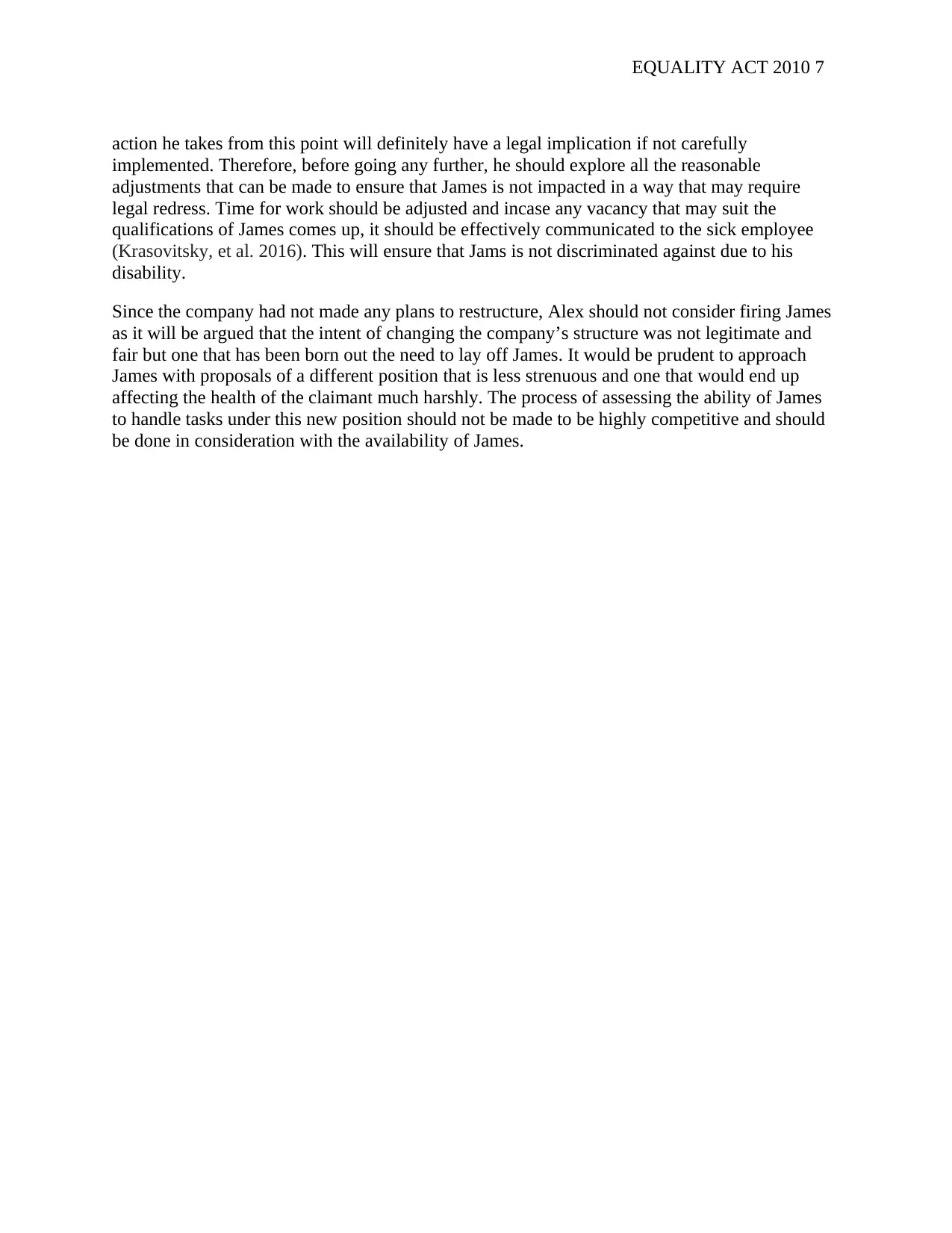
EQUALITY ACT 2010 7
action he takes from this point will definitely have a legal implication if not carefully
implemented. Therefore, before going any further, he should explore all the reasonable
adjustments that can be made to ensure that James is not impacted in a way that may require
legal redress. Time for work should be adjusted and incase any vacancy that may suit the
qualifications of James comes up, it should be effectively communicated to the sick employee
(Krasovitsky, et al. 2016). This will ensure that Jams is not discriminated against due to his
disability.
Since the company had not made any plans to restructure, Alex should not consider firing James
as it will be argued that the intent of changing the company’s structure was not legitimate and
fair but one that has been born out the need to lay off James. It would be prudent to approach
James with proposals of a different position that is less strenuous and one that would end up
affecting the health of the claimant much harshly. The process of assessing the ability of James
to handle tasks under this new position should not be made to be highly competitive and should
be done in consideration with the availability of James.
action he takes from this point will definitely have a legal implication if not carefully
implemented. Therefore, before going any further, he should explore all the reasonable
adjustments that can be made to ensure that James is not impacted in a way that may require
legal redress. Time for work should be adjusted and incase any vacancy that may suit the
qualifications of James comes up, it should be effectively communicated to the sick employee
(Krasovitsky, et al. 2016). This will ensure that Jams is not discriminated against due to his
disability.
Since the company had not made any plans to restructure, Alex should not consider firing James
as it will be argued that the intent of changing the company’s structure was not legitimate and
fair but one that has been born out the need to lay off James. It would be prudent to approach
James with proposals of a different position that is less strenuous and one that would end up
affecting the health of the claimant much harshly. The process of assessing the ability of James
to handle tasks under this new position should not be made to be highly competitive and should
be done in consideration with the availability of James.
Paraphrase This Document
Need a fresh take? Get an instant paraphrase of this document with our AI Paraphraser
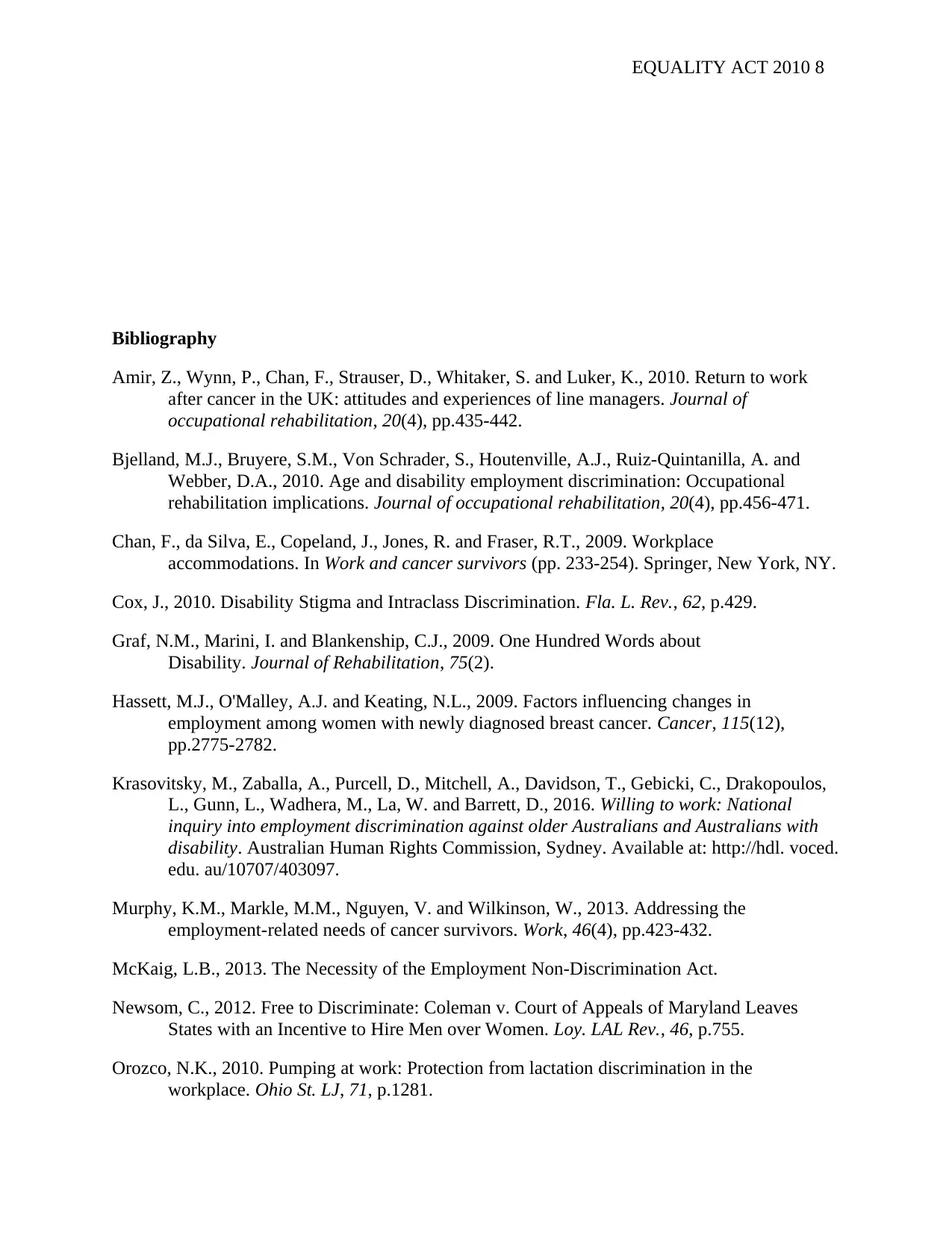
EQUALITY ACT 2010 8
Bibliography
Amir, Z., Wynn, P., Chan, F., Strauser, D., Whitaker, S. and Luker, K., 2010. Return to work
after cancer in the UK: attitudes and experiences of line managers. Journal of
occupational rehabilitation, 20(4), pp.435-442.
Bjelland, M.J., Bruyere, S.M., Von Schrader, S., Houtenville, A.J., Ruiz-Quintanilla, A. and
Webber, D.A., 2010. Age and disability employment discrimination: Occupational
rehabilitation implications. Journal of occupational rehabilitation, 20(4), pp.456-471.
Chan, F., da Silva, E., Copeland, J., Jones, R. and Fraser, R.T., 2009. Workplace
accommodations. In Work and cancer survivors (pp. 233-254). Springer, New York, NY.
Cox, J., 2010. Disability Stigma and Intraclass Discrimination. Fla. L. Rev., 62, p.429.
Graf, N.M., Marini, I. and Blankenship, C.J., 2009. One Hundred Words about
Disability. Journal of Rehabilitation, 75(2).
Hassett, M.J., O'Malley, A.J. and Keating, N.L., 2009. Factors influencing changes in
employment among women with newly diagnosed breast cancer. Cancer, 115(12),
pp.2775-2782.
Krasovitsky, M., Zaballa, A., Purcell, D., Mitchell, A., Davidson, T., Gebicki, C., Drakopoulos,
L., Gunn, L., Wadhera, M., La, W. and Barrett, D., 2016. Willing to work: National
inquiry into employment discrimination against older Australians and Australians with
disability. Australian Human Rights Commission, Sydney. Available at: http://hdl. voced.
edu. au/10707/403097.
Murphy, K.M., Markle, M.M., Nguyen, V. and Wilkinson, W., 2013. Addressing the
employment-related needs of cancer survivors. Work, 46(4), pp.423-432.
McKaig, L.B., 2013. The Necessity of the Employment Non-Discrimination Act.
Newsom, C., 2012. Free to Discriminate: Coleman v. Court of Appeals of Maryland Leaves
States with an Incentive to Hire Men over Women. Loy. LAL Rev., 46, p.755.
Orozco, N.K., 2010. Pumping at work: Protection from lactation discrimination in the
workplace. Ohio St. LJ, 71, p.1281.
Bibliography
Amir, Z., Wynn, P., Chan, F., Strauser, D., Whitaker, S. and Luker, K., 2010. Return to work
after cancer in the UK: attitudes and experiences of line managers. Journal of
occupational rehabilitation, 20(4), pp.435-442.
Bjelland, M.J., Bruyere, S.M., Von Schrader, S., Houtenville, A.J., Ruiz-Quintanilla, A. and
Webber, D.A., 2010. Age and disability employment discrimination: Occupational
rehabilitation implications. Journal of occupational rehabilitation, 20(4), pp.456-471.
Chan, F., da Silva, E., Copeland, J., Jones, R. and Fraser, R.T., 2009. Workplace
accommodations. In Work and cancer survivors (pp. 233-254). Springer, New York, NY.
Cox, J., 2010. Disability Stigma and Intraclass Discrimination. Fla. L. Rev., 62, p.429.
Graf, N.M., Marini, I. and Blankenship, C.J., 2009. One Hundred Words about
Disability. Journal of Rehabilitation, 75(2).
Hassett, M.J., O'Malley, A.J. and Keating, N.L., 2009. Factors influencing changes in
employment among women with newly diagnosed breast cancer. Cancer, 115(12),
pp.2775-2782.
Krasovitsky, M., Zaballa, A., Purcell, D., Mitchell, A., Davidson, T., Gebicki, C., Drakopoulos,
L., Gunn, L., Wadhera, M., La, W. and Barrett, D., 2016. Willing to work: National
inquiry into employment discrimination against older Australians and Australians with
disability. Australian Human Rights Commission, Sydney. Available at: http://hdl. voced.
edu. au/10707/403097.
Murphy, K.M., Markle, M.M., Nguyen, V. and Wilkinson, W., 2013. Addressing the
employment-related needs of cancer survivors. Work, 46(4), pp.423-432.
McKaig, L.B., 2013. The Necessity of the Employment Non-Discrimination Act.
Newsom, C., 2012. Free to Discriminate: Coleman v. Court of Appeals of Maryland Leaves
States with an Incentive to Hire Men over Women. Loy. LAL Rev., 46, p.755.
Orozco, N.K., 2010. Pumping at work: Protection from lactation discrimination in the
workplace. Ohio St. LJ, 71, p.1281.
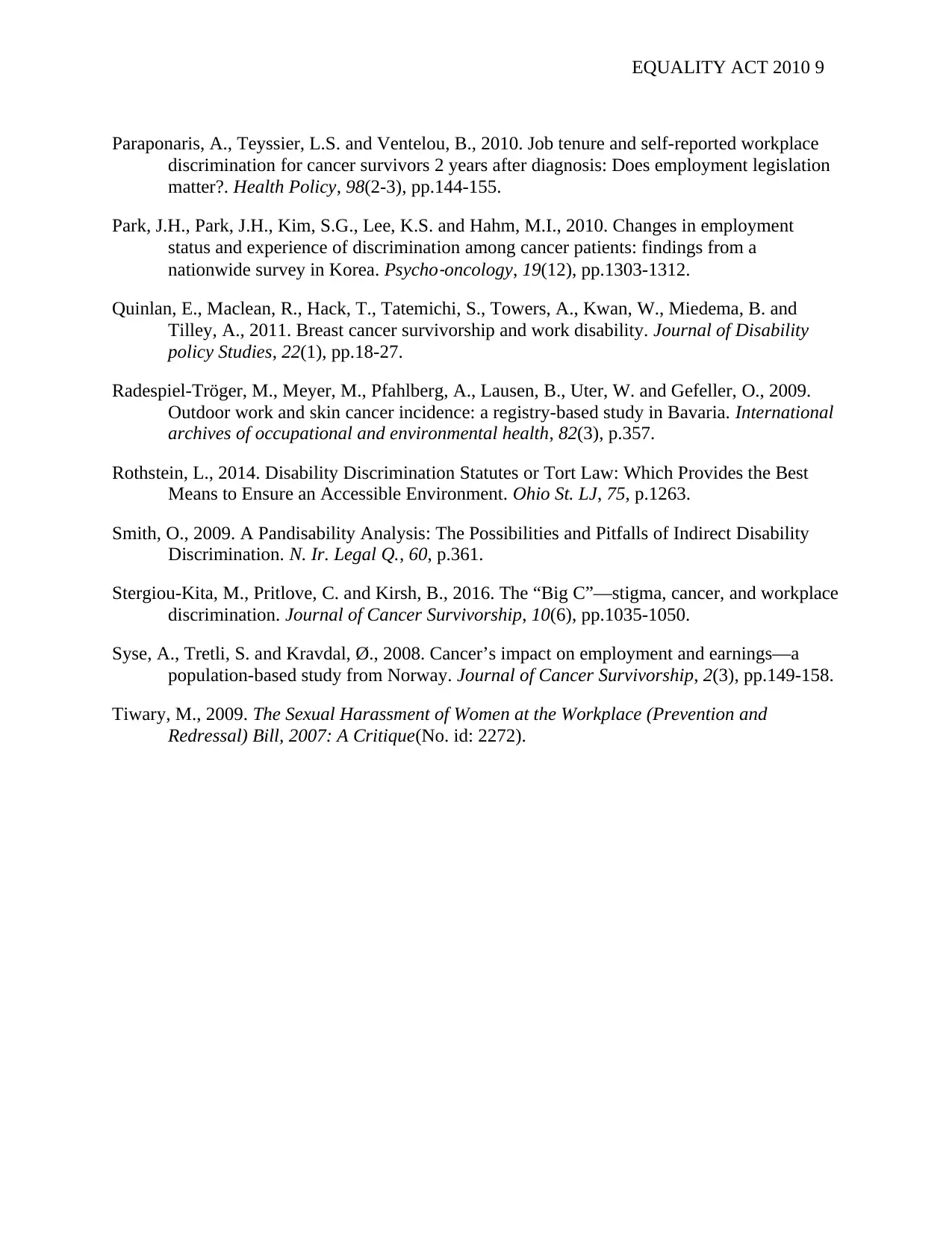
EQUALITY ACT 2010 9
Paraponaris, A., Teyssier, L.S. and Ventelou, B., 2010. Job tenure and self-reported workplace
discrimination for cancer survivors 2 years after diagnosis: Does employment legislation
matter?. Health Policy, 98(2-3), pp.144-155.
Park, J.H., Park, J.H., Kim, S.G., Lee, K.S. and Hahm, M.I., 2010. Changes in employment
status and experience of discrimination among cancer patients: findings from a
nationwide survey in Korea. Psycho
‐oncology, 19(12), pp.1303-1312.
Quinlan, E., Maclean, R., Hack, T., Tatemichi, S., Towers, A., Kwan, W., Miedema, B. and
Tilley, A., 2011. Breast cancer survivorship and work disability. Journal of Disability
policy Studies, 22(1), pp.18-27.
Radespiel-Tröger, M., Meyer, M., Pfahlberg, A., Lausen, B., Uter, W. and Gefeller, O., 2009.
Outdoor work and skin cancer incidence: a registry-based study in Bavaria. International
archives of occupational and environmental health, 82(3), p.357.
Rothstein, L., 2014. Disability Discrimination Statutes or Tort Law: Which Provides the Best
Means to Ensure an Accessible Environment. Ohio St. LJ, 75, p.1263.
Smith, O., 2009. A Pandisability Analysis: The Possibilities and Pitfalls of Indirect Disability
Discrimination. N. Ir. Legal Q., 60, p.361.
Stergiou-Kita, M., Pritlove, C. and Kirsh, B., 2016. The “Big C”—stigma, cancer, and workplace
discrimination. Journal of Cancer Survivorship, 10(6), pp.1035-1050.
Syse, A., Tretli, S. and Kravdal, Ø., 2008. Cancer’s impact on employment and earnings—a
population-based study from Norway. Journal of Cancer Survivorship, 2(3), pp.149-158.
Tiwary, M., 2009. The Sexual Harassment of Women at the Workplace (Prevention and
Redressal) Bill, 2007: A Critique(No. id: 2272).
Paraponaris, A., Teyssier, L.S. and Ventelou, B., 2010. Job tenure and self-reported workplace
discrimination for cancer survivors 2 years after diagnosis: Does employment legislation
matter?. Health Policy, 98(2-3), pp.144-155.
Park, J.H., Park, J.H., Kim, S.G., Lee, K.S. and Hahm, M.I., 2010. Changes in employment
status and experience of discrimination among cancer patients: findings from a
nationwide survey in Korea. Psycho
‐oncology, 19(12), pp.1303-1312.
Quinlan, E., Maclean, R., Hack, T., Tatemichi, S., Towers, A., Kwan, W., Miedema, B. and
Tilley, A., 2011. Breast cancer survivorship and work disability. Journal of Disability
policy Studies, 22(1), pp.18-27.
Radespiel-Tröger, M., Meyer, M., Pfahlberg, A., Lausen, B., Uter, W. and Gefeller, O., 2009.
Outdoor work and skin cancer incidence: a registry-based study in Bavaria. International
archives of occupational and environmental health, 82(3), p.357.
Rothstein, L., 2014. Disability Discrimination Statutes or Tort Law: Which Provides the Best
Means to Ensure an Accessible Environment. Ohio St. LJ, 75, p.1263.
Smith, O., 2009. A Pandisability Analysis: The Possibilities and Pitfalls of Indirect Disability
Discrimination. N. Ir. Legal Q., 60, p.361.
Stergiou-Kita, M., Pritlove, C. and Kirsh, B., 2016. The “Big C”—stigma, cancer, and workplace
discrimination. Journal of Cancer Survivorship, 10(6), pp.1035-1050.
Syse, A., Tretli, S. and Kravdal, Ø., 2008. Cancer’s impact on employment and earnings—a
population-based study from Norway. Journal of Cancer Survivorship, 2(3), pp.149-158.
Tiwary, M., 2009. The Sexual Harassment of Women at the Workplace (Prevention and
Redressal) Bill, 2007: A Critique(No. id: 2272).
⊘ This is a preview!⊘
Do you want full access?
Subscribe today to unlock all pages.

Trusted by 1+ million students worldwide
1 out of 9
Related Documents
Your All-in-One AI-Powered Toolkit for Academic Success.
+13062052269
info@desklib.com
Available 24*7 on WhatsApp / Email
![[object Object]](/_next/static/media/star-bottom.7253800d.svg)
Unlock your academic potential
Copyright © 2020–2025 A2Z Services. All Rights Reserved. Developed and managed by ZUCOL.




